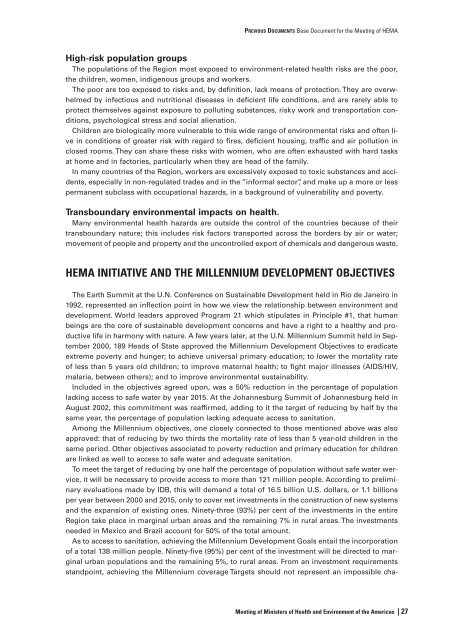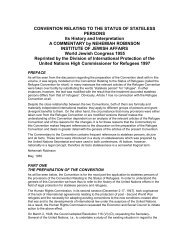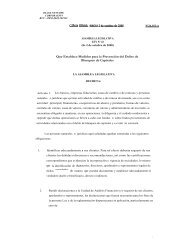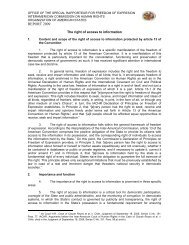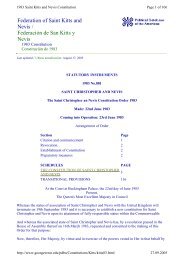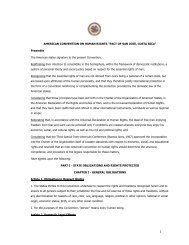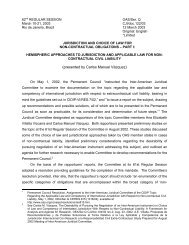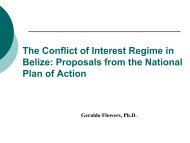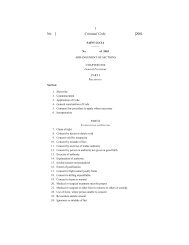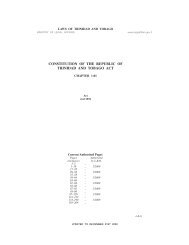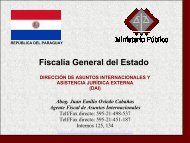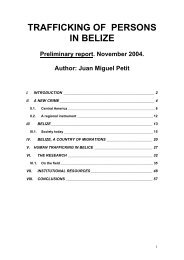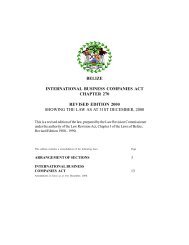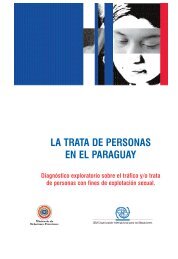(HEMA) Initiative. - OAS
(HEMA) Initiative. - OAS
(HEMA) Initiative. - OAS
You also want an ePaper? Increase the reach of your titles
YUMPU automatically turns print PDFs into web optimized ePapers that Google loves.
PREVIOUS DOCUMENTS Base Document for the Meeting of <strong>HEMA</strong><br />
High-risk population groups<br />
The populations of the Region most exposed to environment-related health risks are the poor,<br />
the children, women, indigenous groups and workers.<br />
The poor are too exposed to risks and, by definition, lack means of protection. They are overwhelmed<br />
by infectious and nutritional diseases in deficient life conditions, and are rarely able to<br />
protect themselves against exposure to polluting substances, risky work and transportation conditions,<br />
psychological stress and social alienation.<br />
Children are biologically more vulnerable to this wide range of environmental risks and often live<br />
in conditions of greater risk with regard to fires, deficient housing, traffic and air pollution in<br />
closed rooms. They can share these risks with women, who are often exhausted with hard tasks<br />
at home and in factories, particularly when they are head of the family.<br />
In many countries of the Region, workers are excessively exposed to toxic substances and accidents,<br />
especially in non-regulated trades and in the “informal sector”, and make up a more or less<br />
permanent subclass with occupational hazards, in a background of vulnerability and poverty.<br />
Transboundary environmental impacts on health.<br />
Many environmental health hazards are outside the control of the countries because of their<br />
transboundary nature; this includes risk factors transported across the borders by air or water;<br />
movement of people and property and the uncontrolled export of chemicals and dangerous waste.<br />
<strong>HEMA</strong> INITIATIVE AND THE MILLENNIUM DEVELOPMENT OBJECTIVES<br />
The Earth Summit at the U.N. Conference on Sustainable Development held in Rio de Janeiro in<br />
1992, represented an inflection point in how we view the relationship between environment and<br />
development. World leaders approved Program 21 which stipulates in Principle #1, that human<br />
beings are the core of sustainable development concerns and have a right to a healthy and productive<br />
life in harmony with nature. A few years later, at the U.N. Millennium Summit held in September<br />
2000, 189 Heads of State approved the Millennium Development Objectives to eradicate<br />
extreme poverty and hunger; to achieve universal primary education; to lower the mortality rate<br />
of less than 5 years old children; to improve maternal health; to fight major illnesses (AIDS/HIV,<br />
malaria, between others); and to improve environmental sustainability.<br />
Included in the objectives agreed upon, was a 50% reduction in the percentage of population<br />
lacking access to safe water by year 2015. At the Johannesburg Summit of Johannesburg held in<br />
August 2002, this commitment was reaffirmed, adding to it the target of reducing by half by the<br />
same year, the percentage of population lacking adequate access to sanitation.<br />
Among the Millennium objectives, one closely connected to those mentioned above was also<br />
approved: that of reducing by two thirds the mortality rate of less than 5 year-old children in the<br />
same period. Other objectives associated to poverty reduction and primary education for children<br />
are linked as well to access to safe water and adequate sanitation.<br />
To meet the target of reducing by one half the percentage of population without safe water wervice,<br />
it will be necessary to provide access to more than 121 million people. According to preliminary<br />
evaluations made by IDB, this will demand a total of 16.5 billion U.S. dollars, or 1.1 billions<br />
per year between 2000 and 2015, only to cover net investments in the construction of new systems<br />
and the expansion of existing ones. Ninety-three (93%) per cent of the investments in the entire<br />
Region take place in marginal urban areas and the remaining 7% in rural areas. The investments<br />
needed in Mexico and Brazil account for 50% of the total amount.<br />
As to access to sanitation, achieving the Millennium Development Goals entail the incorporation<br />
of a total 138 million people. Ninety-five (95%) per cent of the investment will be directed to marginal<br />
urban populations and the remaining 5%, to rural areas. From an investment requirements<br />
standpoint, achieving the Millennium coverage Targets should not represent an impossible cha-<br />
Meeting of Ministers of Health and Environment of the Americas | 27


